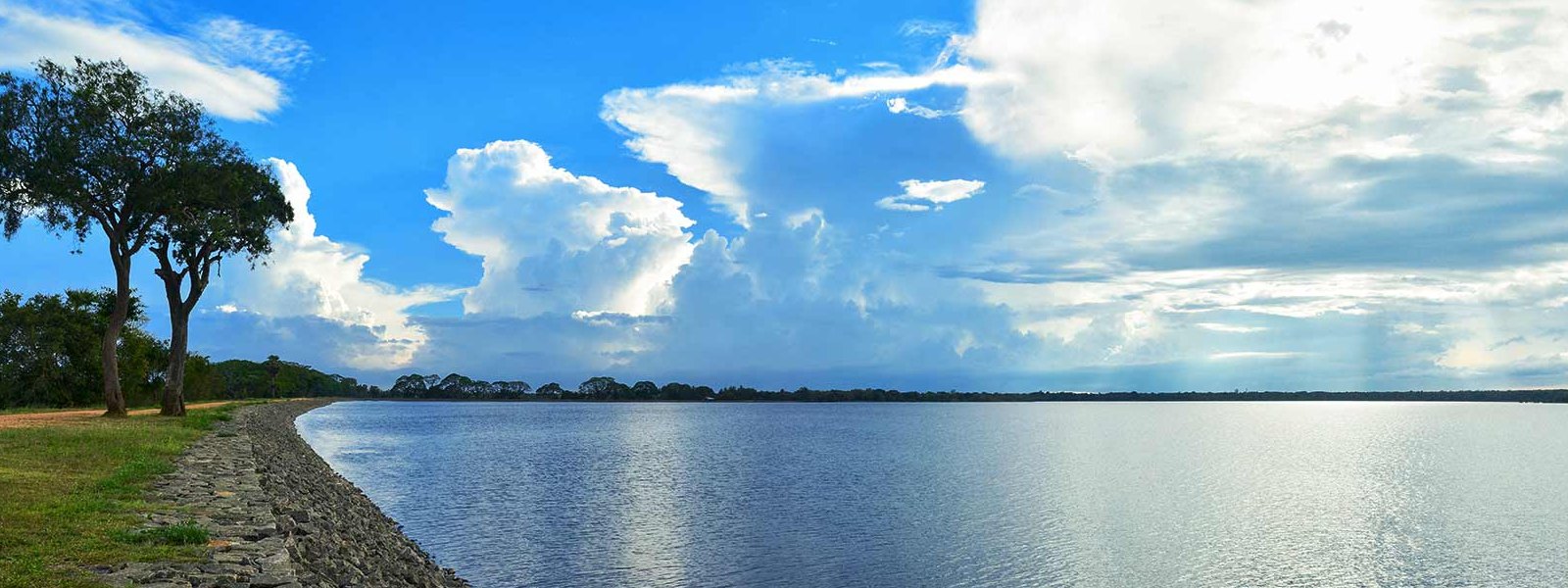.webp)

The Worlds Greatest Ancient Water Civilization - A Special Editorial
The 3,000 year-old system that still serves its people. Sri Lanka’s hydraulic heritage must be understood in order to be protected; the ancient Philosophy of Water and Soil Conservation in an Island-Civilization that was the amongst the greatest in the world.
This essay will introduce you to the very basic principals upon which our Hydraulic Civilization was built upon.
And hopefully, it will inspire you to do your own research, and discovery our amazing heritage.
A quote attributed to the great Sri Lankan King, Parakramabahu (1153–1186) and cited in Sri Lanka’s historic chronical, the Mahawamsa, has been misquoted and as a result, misunderstood for decades. In it, the King decrees that
‘…not even a little drop of water that comes from the rain must flow into the ocean without being made useful to man”.
In fact, the Great King never used the word ‘man’. The Mahavamsa quotes him to have challenged his Kingdom to not allow a single drop of rainwater from being released into the Ocean without it being used and reused for the
‘…benefit of all the earth’.
The Sinhala translation of the Pali word used is, ‘Lokopakarayen’.
This one, powerful word captures the essence of Sri Lanka’s ancient hydraulic heritage philosophy- one that was designed to protect the environment with man being part of that environment and not solely for the benefit of man alone.
While the West has woken up to the importance of sustainability of late, the Sri Lankan civilization was built on a culture of sustainability that lasted for thousands of years.
A key misconception that must be righted is the fact that we often think our water heritage is limited to our irrigation systems.
An irrigation system is a function of hydraulic engineers who will see water as ‘inanimate and active’ but rather the conservationist and farmer will see water from the perspective of it being animate and passive.
The consequences of this difference in understanding our water resources has been disastrous especially in modern times.
Irrigation planners and engineers essentially look at ways of moving water from A to B in the most efficient and effective manner.
Whereas the meandering process of our ancient conservationists took into consideration soil nourishment, filtration, sustaining wildlife and forests, and most importantly replenishing and recycling water.
It was this holistic approach to water management that led to the creation of some of the most stupendous water works the world has ever seen.
Sri Lanka’s ancient water systems include large and small-tanks, river diversions, storage systems and interconnected canals. Of this, perhaps only the largest ‘storage reservoirs’ have become part of popular history and touted as showpieces of our historic prowess as a hydraulic civilization.
One would be hard-pressed to find a political speech or a patriotic song that does not refer to our ‘wewa’s and the Kings who led their construction.
But to understand the extent of this hydraulic heritage is an entirely separate exercise that demands an understanding not only of Sri Lanka’s murky history in the context of parallel world civilizations but also of our geology and weather patterns etc.
As they say, the truth is stranger than fiction. While irrigation and storage are a main function of water management, flood control, drainage and conservation of water, soil and biomass are equally important.
And to achieve this our ancients devised ingenious innovations that stood the test of time.
For instance, when the British colonialists discovered the Minneriya ‘tank’ built by King Mahasen in the 4th Century, the earthen dam had not been breached and was in perfect working condition. A system that had lasted over 15 Centuries and remained operational.
I cannot think of anything else, anywhere in the world, that can bare testament to such sustainable effectiveness.
Strength as defined in the Sri Lankan hydraulic heritage context then is less about solidity and rigidity and more about a seamless integration into a larger philosophy that works in harmony with nature and therefore, lasts longer.
This is the major impasse between modern irrigation thinking and the sustainable structures of our ancients.
‘Cascade Systems’- small tank clusters, a wonder of the world
Very early in Sri Lankan history, our people acquired the art of conserving rain water to tide over the long annual drought that afflicts three fourths of the country, and the bunding-up of rivers and streams, according to our historical records has been an established science even before the arrival of Vijaya in 543 BC.
Increasing sophistication led to the evolution of multi-purpose projects, with conveyance structures linking many a river-basin spread over wide tracts of territory, and the utilization of her waterways for storage, regulation, irrigation, flood-protection, trans-basin diversion, water transport and fisheries, practiced with exceptional skill by our ancients until around the 5th Century AD.
It can be said that Sri Lanka had attained the zenith of her ‘tank’ or ‘wew’ civilization and well over twelve thousand man-made reservoirs adorned her landscape; that’s approximately one for every two square miles of territory.
An intensity of irrigation effort that perhaps no other civilization can claim to equal. Our ancient Kings in their wisdom and foresight, pushed to the very limits, the resources and technology available to them at the time, and to which the ruined remains of their mighty handiwork bear testimony for present-day leaders to ponder over with admiration and, shame, no doubt.
For what might our ancestors have achieved had they but a fraction of the technology and know-how at our command today?
So, what is a ‘Cascade System’, exactly?
There’s no way to simplify these systems but I will try. Think of the undulating geography of Sri Lanka’s dry zone. The rise and fall of the topography of the land meant that, naturally, rainwater would flow and then collect in certain areas.
Our ancients observed these natural occurrences over time and began to think of ways to harness this natural behavior to structure their farming around the ready supply of water.
And so, what they did, was construct barriers at certain locations that would in effect, create storage areas. The storage ‘tanks’ were then connected via canals and sometimes, ducts, to each other creating a link of anywhere between 3 to sometimes 30 small tanks that acted in unison to irrigate and nourish a definable area.
It was around this ‘system’ that our villages were formed, and thereby, our culture.
Unfortunately, today, the ‘Wewa’, is inappropriately referred to as a ‘tank’. Writing on Lessons from Civilization Principle of Wewa for World Peace Policy, Engineer SK Sooriyarachchi, perhaps put it best when he defined the system, by virtue of its concept, as-
“an ‘ecosystem’ itself, neither an isolated reservoir nor a number of reservoirs linked together in a cascade but rather a composite ecosystem comprising of a cascade of reservoirs associated with its own catchment, supporting human life and livelihoods such as paddy cultivation, people and animals associated with it, the soil and ground water table and al altogether pleasant environment around it”.
The Sri Lankan ‘wewa’ and ‘canal’ systems- a technological marvel
The first question our ancients had to answer when thinking about building a ‘wewa’, was the geography of the area. Selecting the location and then ‘bunding’ the appropriate gaps was done using earthen material.
What is important to note here is that our ancient engineers never really ‘built’ entire reservoirs as we might sometimes imagine they did. What they did was, instead, ingeniously, ‘bund’, the right areas. This is why the Rajarata region in Sri Lanka is called the ‘wew bandi raajya’, and not the ‘wew hedu raajya’. Perhas a negligible difference to some, but significant in the philosophy and approach to Water Management.
Everything was about sustainability and conservation. Not all ‘wew’ were the same. There were different wew for different purposes.
There were ‘Kotu Wew’, which were the smallest and oldest, at most 2–3 acres. The ‘Kulu Wew’ served the very specific function of storing excess water required for larger storage tanks.
What made these wewas special, was a lack of Sluice Gates, as they were not used for irrigation.
They were also called ‘Ulpath Wew’, as they nourished the main wewa with water through a system of seepage.
The ‘Maha Wewa’, or ‘Major Tank’, often covered an area of over 10 Acres and was created as a result of the increasing demand to expand agriculture as Sri Lanka’s population increased, particularly in the period after 1 A.D. ‘Samudra Wew’, are considered to be amongst the largest Wew, and are thus likened to a sea.
Parakramabahu I was the pioneer of these creations.
There are many, many others. Each with a purpose. And each Wewa, in fact would have individual ingenious technological devices such as the Sluice or Sorowwa (there can be many of types with different purposes), the Bisokotuwa, the Kattakaduwa, The Ralapanawa, The Wew Bamma etc.
Each device was cared for by villages tasked with responsibilities under the Rajakariya System.
There were even ‘Wew’ for the animals, placed inside forested areas which prevented elephants from marauding into human settlements. It was considered unlawful for these wew to be used by humans.
I will now describe below, a few examples of the technological innovations used in an individual Wewa, for which I draw reference from Prof. Chandana Withaanachchi’s research and explanations.
The ‘Wew Bamma’ (Bund):
The main purpose of the bund is to hold water in place. This means it has to be build to absorb massive pressure from the thousands of cubic meters of water that is stored within a wewa. It is clear that ancient hydraulic engineers had a deep understanding of the complex mathematics that was required to gauge the design and construction of dimensions a Bund, taking into account the storage requirement.
The ‘Sorowwa’ (Sluice Gate):
The main purpose of the Sorowwa is the release of water to cultivate fields, in the quantity required, at the time required. This control mechanism was one of the most important technological innovations and an advanced form was the invention and use of the ‘Bisokotuwa Sluice’ which was a stone device that was used to reduce the massive pressure built up during the release of water, in order to protect the Sluice Canal, the bund itself and also a release valve, if any. It is a remarkable piece of ancient engineering, and can still be seen at certain locations around Sri Lanka. The Maduru-Oya Sluice, in my humble opinion, is one of the most fascinating as it also includes a brick overlay, that takes the chamber underground, allowing the entire sluice to ‘breathe’ by regulating the seepage released into the earth that protected the sluice chambers that carried the water from the wewa to the fields. There are many other different types of Sorrowa variations that I will not go into here. But needless to say the extent of innovations in the Sluice Technology alone is a thesis waiting to happen.
Canals
Amongst the most amazing ancient innovations, was the Sri Lankan Canal. The chief purpose of the Canal was to carry water from the Sluice to the fields. This sometimes meant, a conveyance of several miles as is seen in the case of the Jaya Ganga, which was constructed to carry water from the Kala Wewa to the Tisa Wewa in Anuradhapura.
The first 17 Miles of this conveyance was designed and constructed at a slope of just 6 inches per mile.
The unusual shape of most canals in Sri Lanka also requires some explanation. Unlike the ugly, concrete ‘Z-D Canal’, that moreorless follows a linear disposition, the ancient canals were designed to follow the topographical contours of the land, with only one side being ‘bunded’. This meant that the water would not only reach the intended target but also, nourish the arid land on either side of the countryside it meandered through. The result of this remarkable design is to be seen in certain parts of the North-Central Province where trees that are endemic to the wet zone are found growing on the banks of the canals.
The ‘Pitavana’
The Pitavana was another key part of the Wewa, allowing excess water to be systematically released, thus preventing any damage to the wewa itself. A single wewa can have more than one ‘Pitavana’, depending on its size. There were three main ways in which engineers built a Pitavana. The first was by selecting an area based on geological rock morphology, second was selecting a highground based on the topography of the area and third, was building a Pitavana on an artificially created highground.
The Ihaththawa
This is the area set apart as the source of water nourishment for the Wewa. It is forested land, and fiercely protected by ancient village administration as it is the source of water for the all-important Wewa. It was an area in which villages were able to obtain herbs, plants and hunt small animals.
Is-Veti
Also known as Pota Veti, this small circulular mound is build just out of the Wew Thavulla, which is the outer most water-boundary of a Wewa. It was built in order to control the flow of inbound water from the Ihatthawa, by posing as a breaker.
Gas-Gommana
The Gas-Gommana is non-catchment forested part of the Ihaththawa and is crucial to the long-term sustenance of the Wewa as it protects the water source and springs. Trees such as Kumbuk, Palu, Weera, Damba etc., grow here in abundance naturally and during the rainy season the roots of these trees also act as natural filters, purifying the water of any salinity as water moves on to the Wewa.
The Kattakaduwa
I cannot overstate the importance of this component of the Sri Lankan Wewa.
Created adjacent to the bund, it forms a swamp-like barrier between the bund wall and the irrigable environment. This part of the Wewa serves to filter water that seeps from under the bund by sending it through several meters of vegetation and silt. By the time the water reaches the fields and other parts of the surrounding environment, the water is lighter and moreorless devoid of any pollutants and salinity.
Ancient designers made use of this area by also growing medicinal herbs in the Kattakaduwa. The water in the Kattakaduwa is testament to its function; often taking a corrosive colour having filtered out the water that makes its way away from the wewa towards the fields.
These are just a few of the technological devices that make up a single Wewa. There are many, many more and I will leave it to the reader to discover the rest either by reading about them or better yet, taking a field trip as a personal odyssey to rediscover one’s own heritage.
"I have purposely used the vernacular terms as there really is no English equivalent in most cases! Sri Lanka has some 30,000 Wewa’s according to some estimates and 900+ discovered Cascade Systems."
The Rajakariya System, today’s environmental challenges and a way forward
The intention of this section is not to advocate the reintroduction of the Rajakariya System.
That would be impossible and implausible. But instead, understanding the roots of the environmental and economic chaos we find ourselves in today is an important step towards unravelling solutions in the future.
Today the administration of rural Sri Lanka is an incredible challenge to say the least. A lack of understanding of how our nation and her people were managed in harmony with our unique environment, and the failure of successive political leaders to take lessons from the pages of history that are freely available, to anyone who cares to pay attention to them, has led to a complete collapse of village administration and prosperity today.
Our people in rural Sri Lanka are like fish out of water; struggling to make sense of modern lives and modern administration that has no care for sustaining a way of life that runs deep in our national psyche.
The Colonial powers who were replaced by their own post-independence consiglieres paid scant regard to our ancient systems of administration and arbitrarily drew lines all over the map, dividing Sri Lanka into so-called administrative districts that were devised more for political and revenue-collection reasons than with the intention of improving the lives of rural Sri Lankans and caring for a sensitive environment.
I would like to quote below, Prof. Tennakoon Wimalanandna, who wrote extensively on ‘The Rajakariya and the British’ particularly in the 70’s, to elaborate on this:
“One example was when the Colebrooke Commission of 1832, in ignorance or intention, recommended the abolishment of the Rajakariya. Thus the Commission, whilst recognizing the benefits that would ensure from the restoration of ancient irrigation works, proceeded to advocate the destruction of the very machinery by which alone these works, when restored, could be maintained. It is highly doubtful whether the Commissioner who made these recommendations fully understood the real workings of the communal machinery, or realized the effects that so drastic a change in customs that had existed from time immemorial, would produce. The practical effect of the law went far beyond the mere abolition of the Rajakariya. It struck at the roots of those very liberties it was intended to preserve. It destroyed the power of co-operation among the people by which alone the irrigation works could be kept in working order; it abolished the power to compel the owner of a share in communal property to contribute his quota of work for the maintenance and protection of that property. Thus, what was everybody’s business became nobody’s business and the industrious majority were placed at the mercy of an indolent few”.
The failure of administration over the decades has led to where we stand today. Or perhaps it is more appropriate to say, where we have fallen to, today.
Just look at the environmental degradation that is around us. Despite having over 100 beautiful, bountiful rivers that flow out into the ocean, over 1,500 named streams that snake through our towns and villages, and between 12,000 and 16,000 small-village ‘Wew’, the Gammadda Reports from 2016–2019 suggest that some 90% of Sri Lankan villages face acute shortages of clean drinking water.
Deforestation will replete the soil of the major share of its ecosystem nutrients and depletetheir function as natural air filters by removing Carbon Dioxide and other air pollutants.
According to Tennakoon, a well grown tree sequestrates 22.5 kg of Carbon Dioxide.
Recently the government announced the rescinding of a Gazette that protected certain portions of State Forests (‘Other State Forests’), with the rationale that farmers needed to farm. This is diametrically opposed to everything this nation has stood for over millennia; a proud culture of harmony and sustainability, replaced with ignorant, self-serving, short-term political decisions that will impact the island for generations to come.
“Up to the 1940’s, the traditional villages in the North-Central Dry Zone remained separated from one another by a forest. Hence, during the early part of the British Administration these were called ‘villages in the jungle’. As they were surrounded by jungle, the people in one village could not even see the other nearby villages. The situation is very different today. From one village one can see the surrounding villages as the forests around them have been butchered leaving the slow re-growing tree stumps and thorny-low thickets or impoverished shrubs. Under the Village Expansion Programmes during the mid-twentieth Century, the original ‘clustered houses’ (Gangoda) at one end of a tank bund have undergone a ribbon like settlement expansion along the village roads in spacious individually owned land extents granted by the government where vegetation remain impoverished. This village expansion, together with the opening of highlight forests for Chena Cultivation has dented or discontinued forest corridors leading to the unending human-elephant conflict as well”
– M.U.A Tennakoon, Cascade based Tank Renovation for Climate Resilience Improvement.
In addition to the deforestation that can be easily seen, the erosion of our focus on conservation as part and parcel of our economic march has resulted in problems that can’t be easily seen but the repercussions are felt everywhere today.
Soil problems, sedimentation, threats to water quality, eutrophication (the increase in Nitrogen and Phosphorus accumulations, making their way into ground water storages), salt accumulation (salinization; happening as we speak in many parts of the country) are just a few of the environmental problems Sri Lanka faces today. And these problems are no longer limited to the backwaters of our villages.
They are today impacting our urban dwellers a lot more than we can imagine. To the people in Colombo for instance, where do you think your food comes from?
The King is Going to do it alone’
The famed scholar, Joseph Needham once noted that the development of a Water Management System in ancient Sri Lanka in its technology and organization has been unparalleled in its sophistication elsewhere in the world.
In fact, it is part of a universal cultural heritage of all humankind. Recognition of as a ‘World Water Heritage System’ by the UN, is a result of this.
The Chulavamsa (88:37–42) tells us how King Vijayabhahu IV, mobilized his chieftains, artisans as well as the people in order to support his vision of restoring the Wew of Polonnaruwa, that had fallen into disuse following years of neglect at the hands of Indian invaders.
When some of the Chieftains and Ministers showed reluctance to support the King, the Chronical says that he went to the people, and won their support. The Chulavamsa says that women took to the streets followed by children, in support of the King’s efforts at restoring the wew, by chanting,
“Our King is going alone, let us follow him!”
Seeing this, the Chieftains and Ministers, no doubt embarrassed to be rendered irrelevant by the King and the people, were forced to support the restoration campaign. And the result of King Vijayabhahus efforts, are still to be seen today.
As we wonder, how we as a nation will grapple with the massive, nearly insurmountable challenges the future holds, behold in your mind, the Sri Lankan Wewa.
A testament of what is possible if we unite. And if we take the time to understand the truth in our history, as opposed to mindless political drivel that has shrouded the stupendous achievements of our forefathers.
“Our King is going alone, let us follow him!”
References:
‘Water Heritage of Sri Lanka’, D.L.O Mendis
‘The History of Irrigation and Agriculture Colonization in Ceylon’, Brohier
‘Cascade Based Tank Renovation for Climate Resilience Improvement’, Tennakoon
‘An Introduction to The Economic Potential of The Rivers and Streams of Sri Lanka’, Samarasekera
‘පුරාණ ශ්රී ලංකාවේ වාරි කර්මාන්තය’, ආචාර්ය චන්දන රෝහණ විතානාච්චි.
Other Articles
Featured News





.png )
-783397_550x300.jpg)


-783261_550x300.jpg)
-783249_550x300.jpg)
-783048_550x300.jpg)

















.gif)